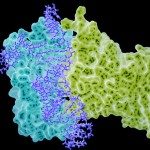Link to Pubmed [PMID] – 18786394
Structure 2008 Sep;16(9):1305-12
The use of generous distance bounds has been the hallmark of NMR structure determination. However, bounds necessitate the estimation of data quality before the calculation, reduce the information content, introduce human bias, and allow for major errors in the structures. Here, we propose a new rapid structure calculation scheme based on Bayesian analysis. The minimization of an extended energy function, including a new type of distance restraint and a term depending on the data quality, results in an estimation of the data quality in addition to coordinates. This allows for the determination of the optimal weight on the experimental information. The resulting structures are of better quality and closer to the X-ray crystal structure of the same molecule. With the new calculation approach, the analysis of discrepancies from the target distances becomes meaningful. The strategy may be useful in other applications-for example, in homology modeling.



